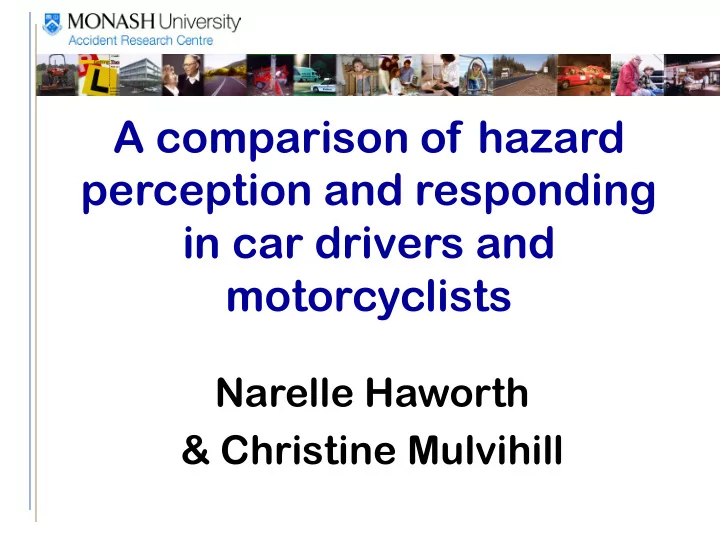

A comparison of hazard perception and responding in car drivers and motorcyclists Narelle Haworth & Christine Mulvihill
Outline • Aims, definition and theories • Differences between novice riders and drivers • Hazards for riders • Crash patterns • Hazard perception research • Training and testing • What has been learnt and where to now? • Applicability to other jurisdictions
Study aimed to examine • Differences between novice drivers and riders in Victoria, Australia in terms of: age and car driving experience hazard perception (HP) and responding • Relevance to rider HP of car driver HP research, testing and training • Implications for rider training programs • Applicability of research to other countries
Definition of hazard • “Any permanent or transitory, stationary or moving object in the road environment that has the potential to increase the risk of a crash. • Hazards exclude characteristics of the rider or the vehicle, which are classed as modifying factors”
Modifying factors • Can be long term characteristics (e.g., experience and skill) • Can be transitory factors (e.g., travel speed, BAC level) • Same object a hazard and modifying factor
Four-component model of risk Responding to risk (Grayson et al. 2003)
Novice riders and drivers • Novice car drivers are both young and inexperienced in car driving • Novice motorcyclists aren’t all young and most are experienced car drivers • So is hazard perception research relevant for riders? • Is overseas research relevant to Victorian motorcycle research? • Riders are not an homogeneous group • Little is known about hazard perception for riders
Hazards for riders Riders: • Face same hazards as car drivers • More susceptible to road based hazards • Require different reactions to hazards than drivers • More likely to be harmed than drivers
Road based hazards • Feature in motorcycle crashes • Road surface conditions - Permanent characteristics - Temporary characteristics • Visual obstructions • Road alignment characteristics
Behaviour of other road users • Easier to identify in crash cause than road based hazards • Failure of car drivers’ hazard perception • Other vehicle at fault in 55-75% serious multi-vehicle motorcycle crashes • Rider at fault in most fatal motorcycle crashes
Crash patterns • Police crash data of limited use in identifying road based hazards • Crash scenarios reflect riding patterns • Earlier crash research shows failures of responding
Hazard perception and responding research • Large number of car driver hazard perception and responding studies • Few studies on motorcycle hazard perception and responding
Hazards reported by riders • 3 different methods to assess drivers’ perceptions of hazards • 70% of hazards mentioned by car drivers with no riding experience arose from behaviour of other road users • Car drivers with riding experience also identified road surface features Armsby, Boyle & Wright (1989)
Rider performance on car driver HPT • Compared 3 groups: – Car drivers with no riding experience – Riders responding as if riding – Riders responding as if driving • HP measured using McKenna & Crick’s (1994) car driver HPT which measures reaction time to detect hazards – not responding • Riders responding as car drivers reacted fastest • Riders have better HP ability than drivers? • HPT disadvantage riders? Horswill and Helman (2001)
Visual scanning patterns of riders and drivers • There is a difference in scanning behaviour between drivers and riders • Studies disagree about the differences • Do riders look more often at road and less into the distance or vice-versa? Nagayama et al., 1980; Tofield & Wann, 2001
Rider training and testing • Response component is more critical for riders but car driver hazard perception training and tests ignore it • Tests focus on detection of hazard only and ignore rider specific hazards • No computerised rider hazard perception test
What has been learnt and where to from here? • Novice riders differ from car drivers in age and experience • We know little about how age and experience (as a rider and as a driver) affect HP and responding • Rider hazard perception research suggests: - road based hazards more important - difficulties for riders lie more in responding - current HPT not appropriate for riders • Need to know more about motorcycle HP and responding before developing training and testing • Stage 2 of research program
Applicability to other jurisdictions • Relevance of our research to other jurisdictions important for developing tailored rider training programs • Likely that riders in other developed countries also differ from car drivers • But need to consider effects of laws and licensing policies • e.g. car and motorcycle/moped licensing ages, stringency of novice licensing restrictions
Recommend
More recommend